Basic definition of basketball cut
A basketball cut is an offensive skill and specific action that a player without possession of the ball can use to move from one location on the court to another with the primary purpose of creating space and getting open from a defender.
Types of basketball cuts
These are examples of the different types of basketball cuts that could be utilized by offensive players during a basketball game.
Also, the offensive players on the following diagrams within this particular section are simply denoted by numbers such as 1, 2, and 3. Additionally, any defensive players are simply denoted by the letter X followed by a number such as X1, X2, etc.
In essence, the players on the court do not have specified roles within this section.
Backdoor cut
The backdoor cut occurs when a player without possession of the basketball seeks to get open, typically by way of an initial quick step towards a player with the ball, followed by an immediate cut to the basket.
Players will typically execute a backdoor cut when a defender is overplaying too high and/or the defender is denying the pass.
The various diagrams below in the sub-section demonstrate basic examples of the backdoor cut.
Example: Backdoor cut from the wing
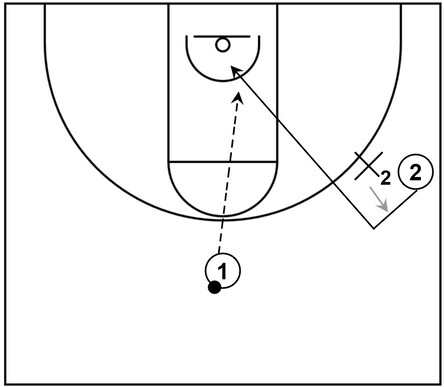
This is an example of a backdoor cut that gets executed by an offensive player near a wing area of the court.
In terms of the basic setup, 1 is at the top in the middle of the floor with possession of the ball, represented by the black dot. Additionally, 2 is located near the right side wing.
Moreover, the defender, simply known as X2, overplays and denies 2 easy possession of the basketball, represented by the gray arrow.
Therefore, as a counter to that, 2 executes a backdoor cut and receives the ball from 1, indicated by the dotted arrow.
Following that, 2 simply scores by way of a layup at the rim.
Example: Backdoor cut from the corner 1
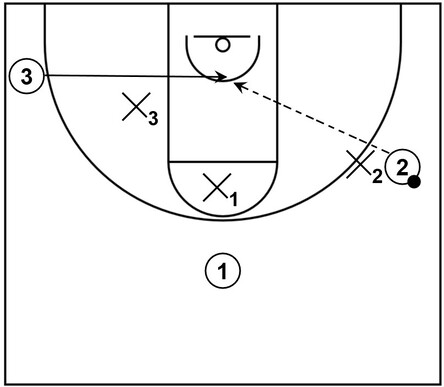
Here is yet another example of a backdoor cut; this time by an offensive player who is initially located in the corner on the weak side, opposite the ball.
Also, in this case, the cutting player does not need to take a step towards the player with the ball. Instead, that same player cuts straight to the basket.
For the setup, 1 is at the top, 2 is near the right side wing with possession of the ball, and 3 is in the left side corner.
Furthermore, the diagram features a handful of defenders who are guarding the offensive players, simply denoted as X1, X2, and X3 respectively.
Additionally, before the offensive cut happens, X3 implements what is generally known as help defense on the court.
Without getting too detailed, since the ball is on one side of the court (in this example, that is the right side of the floor), this means that any defenders on the opposite side of the ball or weak side can help out by sliding more towards the lane lines, especially near the weak side low post or weak side elbow.
However, in this example, X3 on the weak side is overplaying too high while trying to provide help. This gives 3 an opportunity to backdoor cut straight to the basket and receive the ball from 2, which can lead to an easy layup at the rim.
Example: Backdoor cut from the corner 2
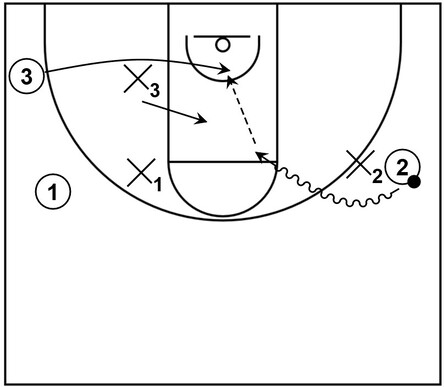
Here is a variation of the previous example. This time, the backdoor cut action happens after dribble penetration occurs.
It should be mentioned as well that this particular variant of backdoor cut is also known as a second cut.
In essence, the potential off-ball cutter reads and reacts to their defender.
If the defender is simply not paying attention or the defender plays up too high, especially to provide help, then that could lead to a second cut opportunity.
On the diagram, 2 is isolated on the right side with possession of the ball.
From there, 2 dribbles toward the basket, indicated by the wavy arrow. What’s more, that action causes X3 to move too far into the lane in an attempt to help stop the dribble penetration.
However, when that happens, 3 can simply backdoor cut behind X3, who has lost sight of the offensive player, receive the ball from 2, and score via a layup.
Related: Villanova Basketball Second Cut Offensive Concept – YouTube
Banana cut
The banana cut occurs when a player performs a curved or arched cut from one area of the court to another.
The diagram below demonstrates a basic example of the banana cut.
Example: Banana cut from the corner to the top
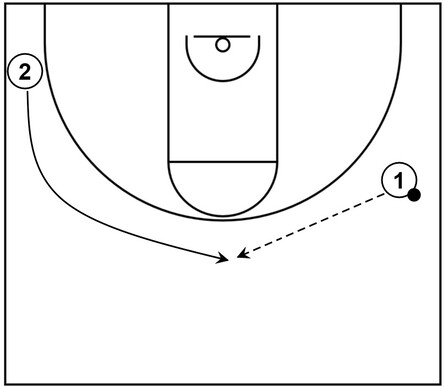
This is an example of a basic banana cut. In terms of the setup, 1 is located near the right side wing with possession of the basketball while 2 is in the left side corner.
From there, 2 executes the banana cut from the left side corner to the top behind the three point line and receives the ball from 1, which could lead to a shot opportunity or drive to the basket.
Baseline cut
The baseline cut occurs when a player runs near the baseline from one area of the court to another area, which is commonly the opposite corner or opposite wing.
The diagram below showcases a basic example of the baseline cut.
Example: Baseline cut 1
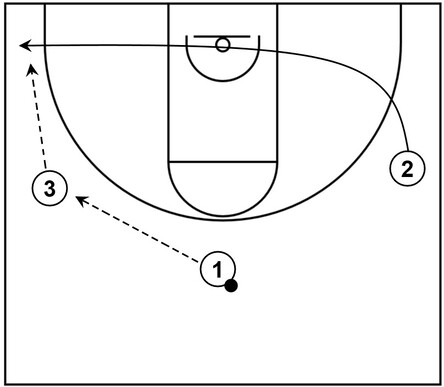
This is an example of the baseline cut involving three offensive players on the court. In terms of the setup, 1 is at the top with possession of the ball, 2 is near the right side wing, and 3 is near the left side wing.
To start the action, 3 receives the ball from 1 while 2 executes the baseline cut through to the left side corner.
Afterwards, 2 receives the ball from 3, which could then lead to a three-point shot, assuming that is open.
Example: Baseline cut 2
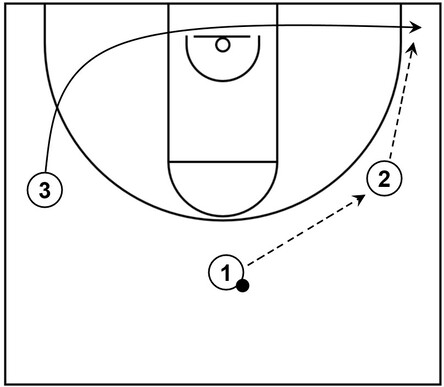
This is another example of a baseline cut from the wing to the opposite corner.
Essentially, in this instance, 2 receives the ball from 1 while 3 runs the baseline behind the basket and cuts to the right side corner.
Afterwards, 3 receives the ball from 2, which could lead to a scoring opportunity.
Furthermore, this particular type of baseline cut could also be considered a deep cut since the cutting player moves from one side of the court to the deep corner.
Curl cut
The curl cut occurs when an offensive player moves from one area of the court to another via a path that features some type of curled or curved motion, especially in combination with an off-ball screen from a teammate.
The simple diagrams below demonstrate examples of curl cuts within offensive action.
Example: Curl cut from the wing to the basket
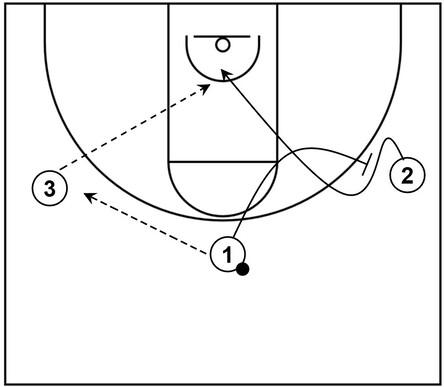
This is an example of a curl cut in which an offensive player moves from the wing towards the basket. In terms of the setup, 1 is at the top, 2 is on the right side wing, and 3 is on the left side wing.
To execute the basic action, 3 receives the ball from 1 and then 1 cuts away to set a screen for 2.
Following that, 2 performs a curl cut by setting up a defender (not shown) by moving slightly towards the baseline before curling around the screen of 1.
Afterwards, 2 receives the ball from 3 and can score via a layup at the basket.
Fundamentals Of The Curl Cut – YouTube
Example: Curl cut from the corner to the basket
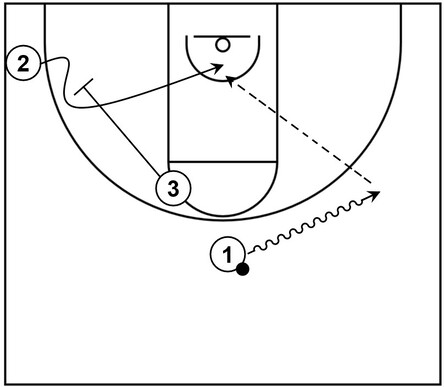
This is an example of a curl cut that features an offensive player moving from the corner to the basket. For the player setup, 1 is at the top, 2 is in the left side corner, and 3 is at the left side high post elbow area.
To begin, 1 performs a dribble entry towards the right side wing. Next, 2 curl cuts to the basket via a wide pin down screen set by 3.
From that point, 2 receives the ball from 1 and scores around the basket via a layup.
Example: Curl cut loop into the lane
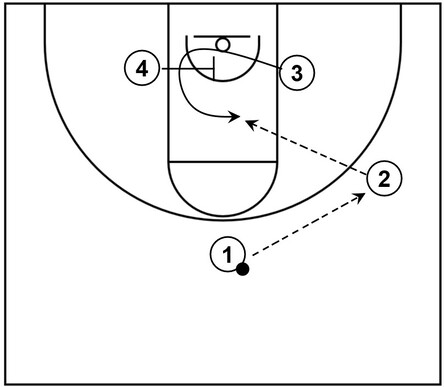
This is yet another example of a curl cut by an offensive player who loops around the low post areas into the lane.
For the setup, 1 is at the top, 2 is on the right side wing, 3 is near the right side low post area, and 4 is near the left side low post area.
To perform the basic action, 2 receives the ball from 1 and while that happens, 3 curl cuts around a screen set by 4 in the lane.
Afterwards, 3 could receive the ball from 2, which could lead to a short jump shot near the basket or a layup.
Dive cut
The dive cut, also known as the straight cut, occurs when a player cuts directly to the basket, particularly in a straight line from their own point of view.
The diagram below showcases a basic example of the dive cut within offensive action.
Example: Dive cut from the top
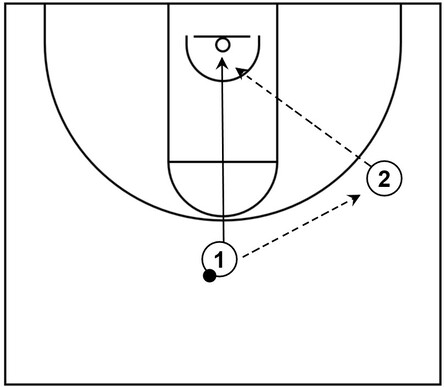
This is a simple example of a dive cut that features 1 at the top and 2 on the right side wing.
To perform the action, 2 receives the ball from 1 who then dive cuts to the basket.
Following that, 1 could receive the ball again and score around the basket.
Additionally, as a brief side note, this offensive action is also a give and go type of scenario because 1 will give the ball to a teammate (2) and then go to the basket.
Drift cut
The drift cut occurs when an offensive player cuts to the corner typically from the wing on the weak side of the court.
The diagram below showcases a basic example of the drift cut.
Example: Drift cut from the weak side wing to the weak side corner
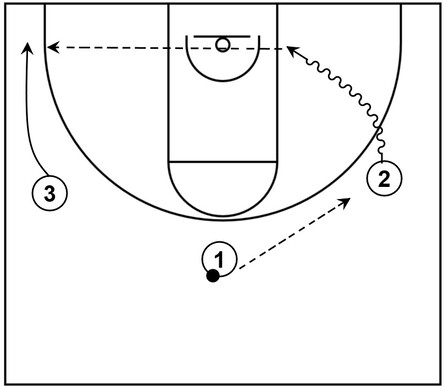
This is a basic example of the drift cut that begins with 1 at the top, 2 on the right side wing, and 3 on the left side wing.
To demonstrate the offensive action, 2 receives the ball from 1 and immediately dribbles toward the basket near the baseline.
As that happens, 3 performs a drift cut to the left side corner, which is also the weak side, opposite the location of the ball.
Next, 2 throws a drift pass across the lane with 3 as the recipient. Following that, 3 can take the open three-point shot.
Face cut
The face cut, also known as a front cut, occurs when an offensive player positions themselves between the ball and the defender.
In other words, the offensive player cuts in front of the defender, as the name implies.
The basic diagram below demonstrates an example of the face cut or front cut.
Example: Face cut from the top to the basket
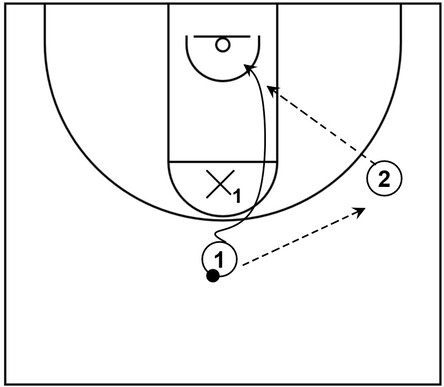
For the simple setup, 1 is at the top in possession of the ball and 2 is near the right side wing.
To perform the action, 1 passes the ball with 2 as the recipient and afterwards, 1 face cuts to the basket in front of the defender X1.
Following that, 1 gets the ball back and can score at the rim via a layup.
Fade cut
The fade cut occurs when a player utilizes an off-ball screen, especially a down screen, to cut towards one area of the court, typically the wing, but afterwards, that same player will then fade back towards another area, which is usually near the adjacent corner.
Essentially, the offensive cutter changes the original path to another destination on the court, commonly as a counter to a defender who attempts to shoot the gap by meeting the off-ball cutter on the other side of the screen.
The diagram below demonstrates the fade cut.
Example: Fade cut towards the corner
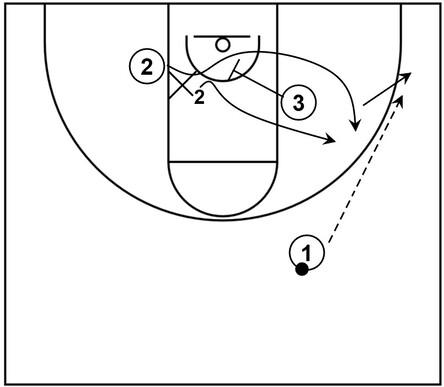
For the basic setup, 1 is at the top, 2 is initially near the left side low post area, and 3 is near the right side mid-post between the high and low post areas.
At the start, 2 begins to cut towards the right side wing via a pin down screen set by 3.
However, the defender known as X2 attempts to shoot the gap of the screen to meet 2 on the opposite side.
So, to counter that, 2 performs the fade cut towards the right side corner, receives the ball from 1, and has an opportunity to take the open jump shot.
Fill cut
The fill cut occurs when an offensive player moves to occupy an empty spot on the court such as the top, wing, slot, or corner, particularly after that space had been previously filled by a teammate.
Furthermore, during offensive execution, if an offensive player cuts to an area that was previously held by a teammate, especially as an immediate secondary action, then that is generally referred to as fill and replace.
As the name implies, the offensive player would be filling the spot and replacing their teammate who once occupied that same spot.
Moreover, when a player cuts directly toward a vacant space, particularly from one perimeter area to another, that is typically known as a blast cut, which is a type of fill cut.
The diagram below demonstrates a basic example of various fill cuts
Example: Various fill cuts towards the top, wing, and corner
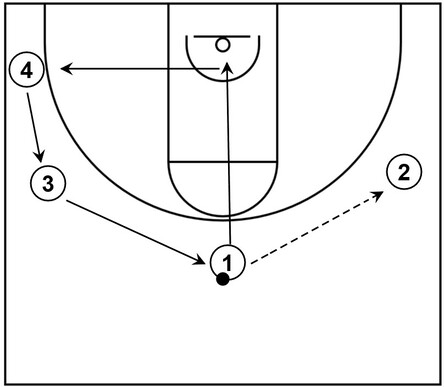
In terms of the basic setup, 1 is at the top, 2 is near the right side wing, 3 is near the left side wing, and 4 is in the left side corner.
To start, 2 receives the ball from 1 who also dive cuts to the basket.
Immediately afterwards, 3 executes the fill cut to the top while 4 and 1 fills the left side wing and corner respectively.
Moreover, for this example, 3 replaced 1, 4 replaced 3, and then 1 replaced 4, all at different locations on the court.
Additionally, the actions by 3 and 4 could be considered blast cuts as well.
Square The Top (Fill Cuts: Blast Cut, V-Cut) – FastModel Sports
Flash cut
The flash cut generally happens when an offensive player moves from a lower part of the court such as the low post area to a higher portion, especially the high post elbow area.
Also, the offensive player will typically cut at an angle as well when moving the lower area to the higher one.
The diagram below demonstrates a simple example of a typical type of flash cut.
Example: Flash cut from low post to high post elbow
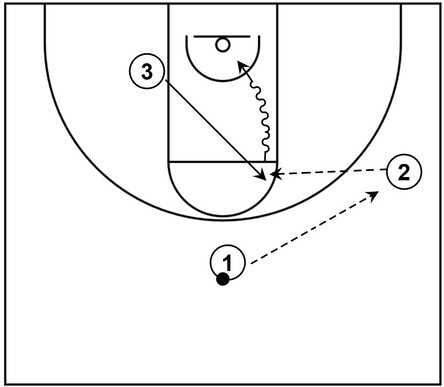
For the basic setup, 1 is at the top, 2 is on the right side wing, and 3 is near the left side low post area.
To begin, 2 receives the ball from 1 and immediately afterwards, 3 flash cuts across the lane from the left side low post to the right side high post elbow area.
From there, 3 could receive the ball from 2 and take the jump shot or perhaps dribble to the basket for a layup.
Iverson cut
The Iverson cut occurs when an offensive player who is initially on one side of the court, typically near a wing area, cuts through to the other side, which is usually the opposite wing area.
The Iverson cut is also generally utilized alongside one or two screens set by additional players for the cutter.
However, it is possible to perform the action without the use of screens as well.
Furthermore, the Iverson cut is named after and popularized by NBA Hall of Famer Allen Iverson who used this type of cut to get open for scoring opportunities.
The basketball diagram below shows a typical example of the Iverson cut in action.
Example: Iverson cut from right side wing to left side wing
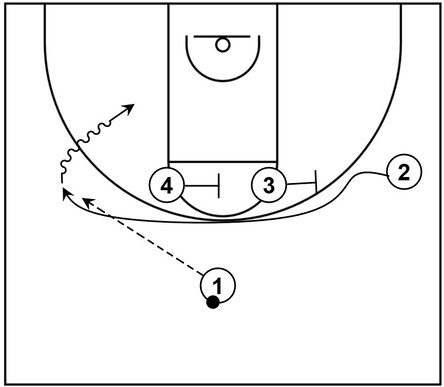
For the setup, 1 is at the top while 2 occupies the right side wing. In addition, 3 and 4 fill the right side and left side high post elbow areas respectively.
To begin, 2 performs the Iverson cut from the right side wing to the left side wing by way of a pair of screens set by 3 and 4.
Afterwards, 2 receives the ball from 1 and has the opportunity to take the three-point shot. Alternatively, 2 could dribble inside the three-point arc for a mid-range shot or possibly drive all the way to the rim for a layup.
L cut
The L cut comprises action in which an offensive player cuts in a certain pattern on the court that is similar to the letter L.
Usually, the offensive player will start near a low post area and then cut initially towards the high post or mid-post area before popping outwards toward the wing area to complete the L-shaped cutting pattern.
The diagram below showcases a simple example of the L cut.
Example: L cut from right side low post to right side wing
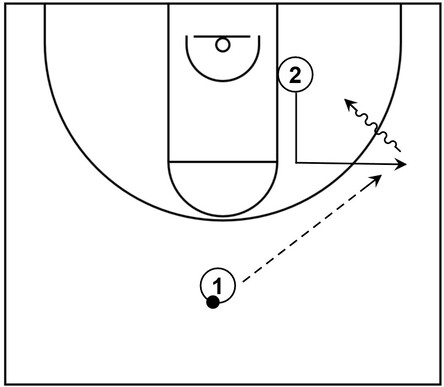
For the basic setup, 1 is at the top with possession of the basketball and 2 is near the right side low post area.
At the start, 2 performs the L-cut by initially cutting towards the right side high post elbow before popping out to the right side wing.
Following that, 2 receives the ball from 1 and has an opportunity to take the three-point shot or potentially dribble inside of the arc for other possible scoring options such as a mid-range shot or layup at the rim.
What’s more, it should be noted although it is not shown on the diagram, 2 should consider taking one step towards the lane to set up the defender prior to popping out towards the wing when completing the L-cut.
The quick step towards the lane could potentially create an adequate amount of separation between 2 and the defender, which could make it even easier to receive the ball.
Laker cut
The Laker cut occurs when an offensive player in possession of the basketball, typically near the wing, passes it to another player near the low post area, and immediately cuts toward the basket.
Afterwards, the cutting player could possibly receive the ball again from the low post player for a scoring opportunity near the basket.
Also, to give a very brief history, the Laker cut derives its name from the Los Angeles Lakers NBA team who utilized it, particularly during their Showtime Era dynasty, in which they won five championships.
The diagram below features a basic example of the Laker cut.
Example: Laker cut from right side wing to basket
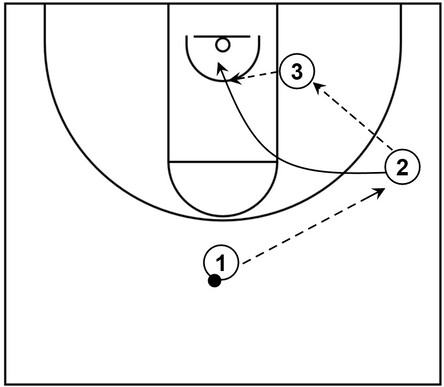
In terms of the setup, 1 is at the top with possession of the ball, 2 is near the right side wing, and 3 is near the right side low post area.
To begin, 2 receives the ball from 1 and then 3 receives it from 2.
After the post entry pass, 2 performs a Laker cut on the high side through the elbow and to the basket.
Following that, 2 can receive the ball again from 3 and score via a layup at the rim.
Scissors cut
The scissors cut occurs when two offensive players, typically near perimeter areas such as the slots, split between another offensive player, usually near the high post.
The cutting players will also move in a pattern that forms somewhat of an X on the court as well.
The diagram below showcases a basic example of the scissors cut action.
Example: Scissors cut from slot areas towards low post areas
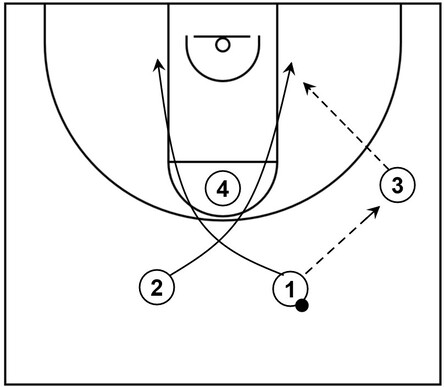
For the basic setup: 1 and 2 are located in the right and left slots respectively; 3 occupies the right side wing area; 4 fills the high post area.
On the diagram example, 3 receives the ball from 1 and afterwards, 1 and 2 perform the scissors cut between 4 towards the low post areas.
In addition, it should be noted that 1 is the first cutter while 2 is the second cutter for this example.
Following that, 2 receives the ball from 3 and has an opportunity to score around the basket via a close-range shot such as a layup.
Shallow cut
The shallow cut occurs when a player who is occupying space at the top, slot, or wing area initially cuts toward the high post area before swiftly changing direction towards the top or adjacent slot or wing, depending on that player’s starting location.
To provide more clarity of this, let’s say an offensive player initially fills the top or slot area. In that case, the player could shallow cut to an adjacent slot or wing area on the court.
Alternatively, let’s say that an offensive player initially occupies one of the wing areas. In that situation, the player could shallow cut to an adjacent slot or fill the top area of the court.
In addition to that, if dribble action is involved, then the player in possession of the ball will typically dribble it towards the area that was recently vacated by the player executing the shallow cut.
What’s more, the shallow cut is commonly used as a method for two teammates to interchange positions on the court.
The diagrams below demonstrate basic examples of the shallow cut within simple offensive action.
Example: Shallow cut from wing area to slot area
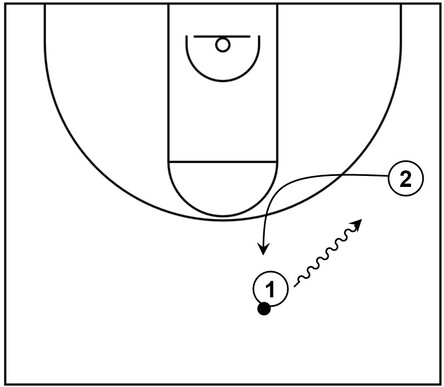
The basic setup only consists of 1 located in the right slot with possession of the basketball and 2 occupying the right side wing area.
From that point, 1 dribbles toward the right side wing and as that occurs, 2 performs a shallow cut toward the high post initially before filling the right side slot area.
Essentially, 2 has exchanged areas of the court with 1.
Example: Shallow cuts from wing and slot areas on weak side
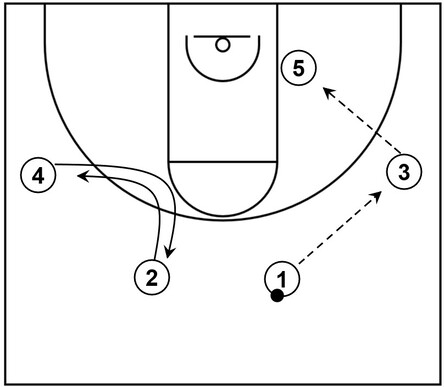
This example include shallow cuts that happen from the wing and slot areas on the weak side opposite the ball.
For the initial setup: 1 and 2 are in the slots; 3 and 4 fill the wings; 5 occupies the right side low post area.
To begin, 3 receives the ball from 1 and then 5 receives it from 3. Also, as that action happens on the strong side, 2 and 4 perform shallow cuts on the weak side to interchange their locations on the floor.
Shuffle cut
The shuffle cut, which is a main staple within the shuffle offense, occurs when a player, typically near the extended slot or wing area, cuts into the lane towards the basket, usually by way of a back screen from a high post player.
The diagram below showcases a basic example of the shuffle cut within offensive execution.
Example: Shuffle cut from extended slot towards basket
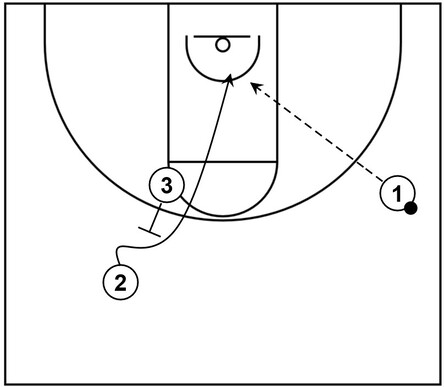
In terms of the initial setup, 1 is near the right side wing with possession of the ball while 2 is positioned near the extended left side slot area. Also, 3 occupies the left side high post elbow area.
From there, 2 performs the shallow cut towards the basket accompanied by a back screen set by 3. Afterwards, 2 receives the ball from 1 and score around the rim.
Slice cut
The slice cut typically occurs when an offensive player moves across the lane from the perimeter, commonly near the wing area, to the opposite mid-post or low post area.
It should be mentioned as well that the slice cut has similarities with the shuffle cut.
The main difference though is that with the shuffle cut, the offensive player generally cuts into the lane towards the basket as opposed to cutting across the lane towards the low post area in reference to the slice cut.
The diagram below showcases a basic example of the slice cut.
Example: Slice cut from wing area across to opposite low post area
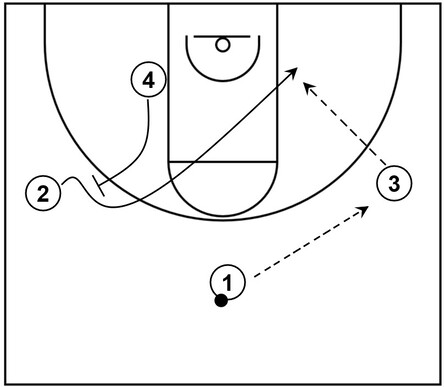
For the setup, 1 is at the top, 2 is on the left side wing, 3 is on the right side wing, and 4 fills the left side low post area.
To start, 3 receives the ball from 1 and immediately afterwards, 2 performs the slice cut from the left side wing across the lane to the right side low post via the screen set by 4.
From that point, 2 could receive the ball from 3 and attempt to score around the basket via a layup or other action such as a low post move.
Slot cut
The slot cut occurs when an offensive player cuts to the basket through a slot area on the court.
The basketball diagrams below demonstrate basic examples of slot cuts on the court.
Example: Slot cut 1
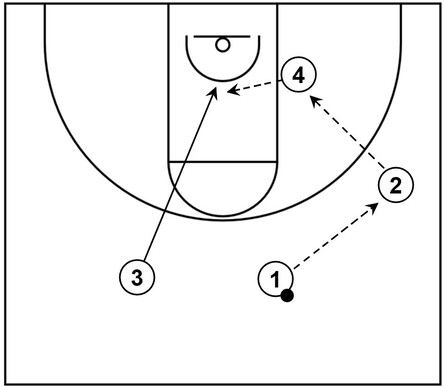
For the initial setup, 1 is in the right slot, 2 is on the right side wing, 3 is in the left slot, and 4 is located at the right side low post area.
To begin, 2 receives the ball from 1 who then throws it inside to 4. Following that, 3 performs the slot cut towards the basket and receives the ball from 4, which could result in a layup.
Example: Slot cut 2
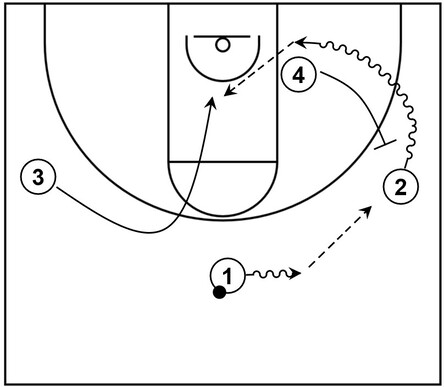
This is another example of a slot cut; however, this time, the cutting player will initially move from the wing to the slot and then towards the rim.
In terms of the setup: 1 is at the top; 2 and 3 occupy the wings; 4 fills the right side low post area.
To begin, 1 dribbles toward the right slot and then 2 receives the ball from 1.
Next, 2 dribbles toward the baseline area via a step-up screen set by 4.
As that happens, 3 initially moves toward the left slot from the left side wing and then executes the slot cut towards the rim via the high post area.
From there, 3 receives the ball from 2 and has an opportunity to score via a field goal attempt such as a layup or dunk.
Additionally, 3 should also try to time the cut so that it is in sequence with the dribble penetration of 2.
In essence, 3 should start moving towards the slot from the wing as soon as 2 uses the step-up screen.
Following that, 3 should begin cutting to the basket through the slot and high post at the moment 2 dribbles toward the lane line on the right side, which is near the baseline as well.
Split cut
The split cut, also known as post split action, occurs when an offensive player near a perimeter area, such as the wing, passes the ball to a teammate near a post area and afterwards, that same perimeter player looks to set or receive a screen from another teammate.
The diagrams below demonstrate basic examples of the split cut during offensive action.
Moreover, for each of the diagrams, the setup features a player at the top, a second player in possession of the basketball near the right side wing, and a third player near the right side low post area.
Example: Split cut 1
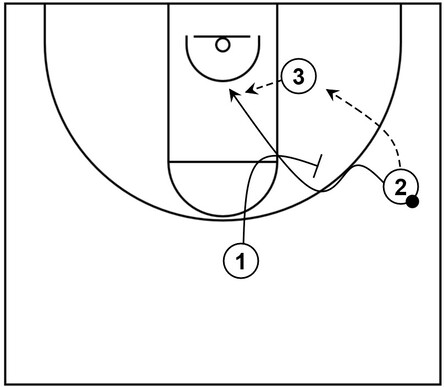
To start the action, 2 throws the entry pass to 3. Afterwards, 2 performs the split cut towards the basket via the off-ball screen set by 1 near the right side high post elbow area.
Following that, 2 can receive the ball again from 3 and score via a layup at the rim.
Related: “Split Cut” – YouTube
Example: Split cut 2
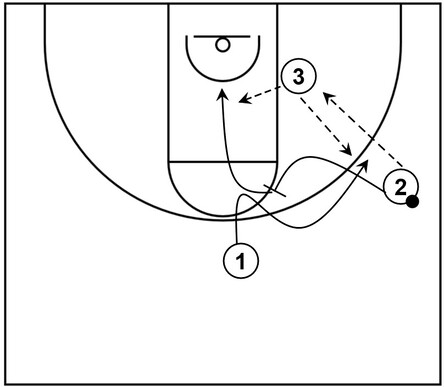
This is another example of a split cut. However, this time, instead of cutting away to receive a screen, 2 will set the screen near the right side elbow for 1.
Afterwards, 1 can use that screen and basically fill the vacant right side wing previously occupied by 2.
From there, 1 could receive the ball from 3, which could lead to a three-point shot opportunity.
Additionally, in some instances such as a defensive switch, 2 could slip the screen and cut to the basket for a possible scoring opportunity at the rim.
Related: Golden State Warriors – Double Drag Split Action ft. Steph Curry – YouTube
UCLA cut
The UCLA cut, derived from the UCLA offense, occurs when an offensive player near the top or slot area cuts to the basket via a high post back screen while an adjacent wing player has possession of the basketball.
The diagram below showcases a basic example of the UCLA cut.
Example: UCLA cut to the basket
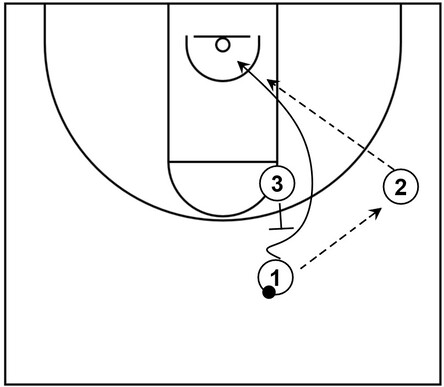
For the basic setup: 1 begins near the right slot with possession of the ball; 2 starts on the right side wing; 3 occupies the right side high post elbow area.
From there, 2 receives the ball from 1 who then cuts to the basket via the back screen set by 3.
After that, 1 receives the ball again from 2 and scores at the rim by way of a layup.
V cut
The V cut occurs when an offensive player moves from one area of the court to another by way of a path that is similar to the letter V.
The diagram below demonstrates a basic V cut that a player can use to get open.
Example: Basic V cut
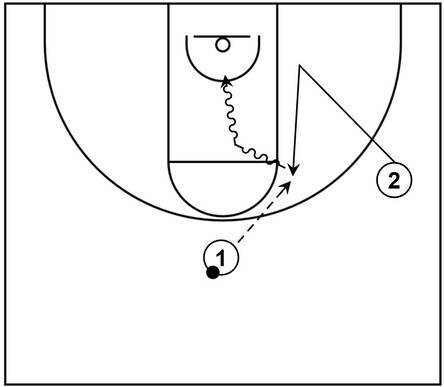
In relation to the initial setup, 1 is at the top and 2 is on the right side wing.
From that point, 2 executes the V cut by initially cutting towards the basket at an angle (to set up the would-be defender) before cutting back upwards adjacent to the right side high post elbow area.
Afterwards, 2 can receive the ball from 1 and take a mid-range shot or possibly attack the rim for a layup.
Zipper cut
The zipper cut occurs when an offensive player cuts from the low post or corner, generally through the lane, to the top.
In addition, the zipper cut is typically utilized alongside a down screen as another offensive tool to help a player get open.
The diagram below demonstrates a very basic zipper cut.
Example: Zipper cut from low post area to top
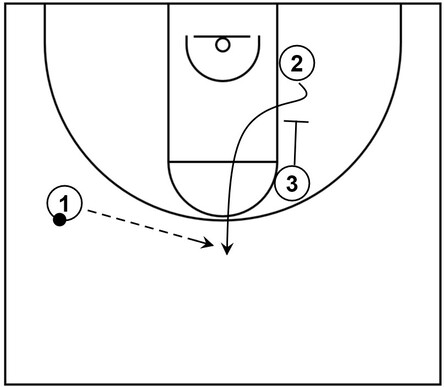
For the initial setup: 1 is near the left side wing with possession of the basketball; 2 fills the right side low post area; 3 occupies the right side high post elbow area.
To start, 3 cuts down toward the low post to set a down screen with 2 as the recipient.
Next, 2 uses that screen and executes the zipper cut through the lane towards the top.
Following that, 2 receives the ball from 1 and has an opportunity to take the three-point shot.
45 cut
The 45 cut occurs when a player without possession of the ball cuts to the basket at a 45 degree angle, typically from the weak side wing.
The diagram below shows an example of a very basic 45 cut, particularly with no defenders.
Example: 45 cut from the wing
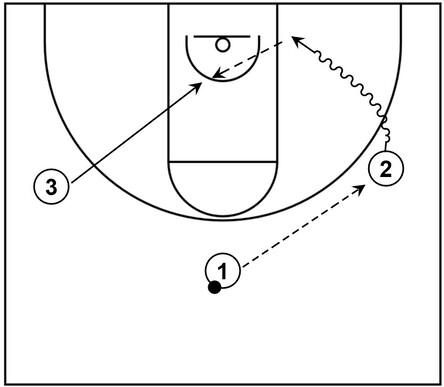
This is an example of a 45 cut by a weak side wing player. In terms of the setup, 1 is at the top, 2 is on the right side wing and 3 is on the left side wing.
Starting off the action, 2 receives the ball from 1 and begins to dribble towards the baseline.
Next, as that happens, 3 performs a 45 cut to the basket from the weak side, opposite the ball.
Afterwards, 3 receives the ball from 2 and scores via a layup or dunk.
Basketball plays with different cuts
This section consists of plays that feature different types of basketball cuts to create scoring opportunities near the basket or around perimeter areas of the court.
Also, any offensive or defensive players within this section are represented by the standard basketball positions with common roles.
Essentially, 1 and X1 represent the offensive and defensive point guard position respectively.
2 and X2 represent the offensive and defensive shooting guard position respectively.
3 and X3 represent the offensive and defensive small forward position respectively.
4 and X4 represent the offensive and defensive power forward position respectively.
5 and X5 represent the offensive and defensive center position repsectively.
Baseline cut play
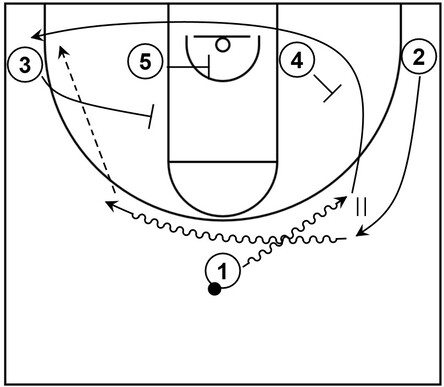
This is an example of a simple 1-4 low play that demonstrates the baseline cut from one side of the court to the opposite corner.
To begin, 1 dribbles toward the right side wing and as that happens, 2 lifts up from the right side corner towards the right side wing.
Afterwards, 1 and 2 execute dribble handoff action, represented by the double pipe symbol.
Following that, 2 dribbles toward the left side wing area while 1 baseline cuts to the left side corner via screens set by 3, 4, and 5.
1 receives the ball from 2 and takes the open three-point shot.
Drift cut play
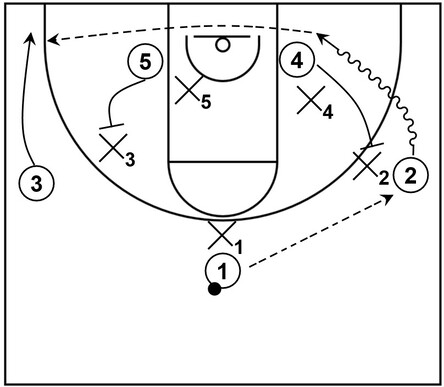
This is an example of a basic hammer set from a 3 out 2 in formation, which includes the drift cut for a possible scoring opportunity.
To start, 2 receives the ball from 1 and afterwards, 4 lifts up to set a step-up screen.
2 uses that screen and dribbles toward the baseline on the right side of the court.
As that happens, 3 performs the drift cut from the left side wing to the adjacent corner, particularly via the hammer screen set by 5.
Next, 2 throws the drift pass with 3 as the receiver. From there, 3 could take the open three-point shot.
Basketball cutting drills
This section contains drills that could be utilized to practice the various types of basketball cuts, particularly for beginners.
The offensive players on the diagrams below are simply denoted by numbers such as 1, 2, and 3.
Moreover, each drill contains at least two or more players unless noted otherwise.
Also, at least one basketball is typically required unless stated otherwise. However, if more than one basketball is available, then that could possibly allow the players to run the drills with greater efficiency.
It should be mentioned too that these drills can be implemented on either side of the court. Nonetheless, the diagrams show one side being used for demonstrative purposes.
Backdoor cut drill
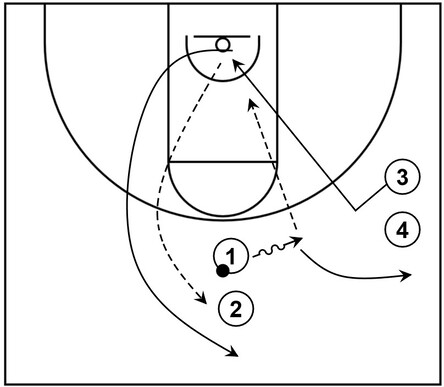
This is an example of a simple backdoor cut drill between several players on the court.
For the initial setup, there are two lines: a dribbling/passing line at the top as well as a cutting line near the right side wing.
Players 1 and 2 are in the line at the top while players 3 and 4 occupy the line near the right side wing.
To start the drill, 1 takes one dribble toward 3. Next, 3 takes a step toward 1 and then immediately backdoor cuts to the rim.
Following that, 3 receives the ball from 1 and scores via the layup. Additionally, as that happens, 1 moves to the back of the cutting line near the right side wing.
After scoring, 3 collects the ball out of the net and passes it with 2 as the recipient, assuming there is only one ball available as shown on the diagram.
However, if there is more than one ball available, then 3 could simply keep possession of it after scoring and quickly move to the back of the passing/dribbling line.
It is not shown on the diagram but after 1 and 3 perform the drill, 2 would fill the space previously occupied by 1 and 4 would fill the space previously occupied by 3.
From that point, 2 would dribble once towards 4 who would backdoor cut and a similar sequence of actions would happen as before.
Dive cut drill
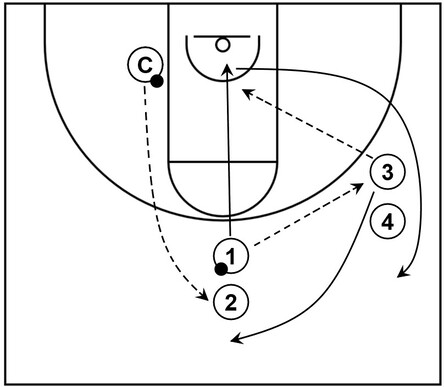
This is an example of a very basic dive cut drill between multiple players on the court in addition to a possible coach.
In reference to the setup, there is a line at the top that consists of players who would make an initial pass followed by a cut to the basket.
Furthermore, there is another line near the right side wing in which players pass to the cutting players from the line at the top.
Additionally, an available coach can get situated around the basket, particularly for rebounding purposes. On the diagram, the coach is represented by the letter C.
To begin the drill, 2 receives the ball from 1 who then swiftly dive cuts to the basket.
Afterwards, 1 receives the ball again from 3, scores the layup, and starts cutting to the back of the line near the right side wing.
3 cuts to the back of the line at the top as well.
Following that, the coach can collect the ball out of the net and pass it to player 2 at the top who would then fill the space previously occupied by 1.
Similarly, 4 would step into the space previously held by 3. From there, 2 and 4 would execute the drill similar to players 1 and 3.
Also, if a coach is not available, then another player could rebound instead.
Alternatively, the cutting players could collect the ball out of the net after scoring the layup and pass it to teammates at the top prior to moving towards the line near the right side wing.